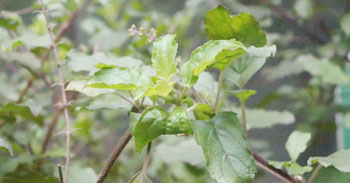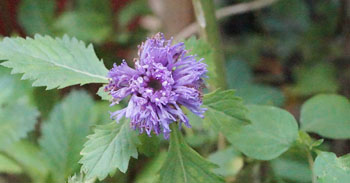KJC Medicinal Garden
Kadu jirage
Centratherum punctatum
Order: Asterales
Family: Asteraceae
Genus: Centratherum
Species: Centratherum punctatum
Others Names: Starflower
Kadu Jirage
Leaves: The plant has green, lance-shaped leaves arranged alternately along the stem.
Flowers: Centratherum punctatum produces small, purple or blue flowers with a distinctive, star-like appearance, which give the plant its common name, Starflower. The flowers are clustered in terminal heads.
Growth Habit: It is an herbaceous plant, typically growing as a shrub or small bush. It can grow to a height of about 1–1.5 meters (3–5 feet).
Fruit: The plant produces achenes (small, dry, one-seeded fruits) after flowering.
Uses in Tradition systems of medicine
Ornamental Uses: Centratherum punctatum is sometimes cultivated for its ornamental flowers, particularly in regions where it thrives in tropical climates.
Traditional Medicinal Uses:
Kadu Jirage has been used in traditional medicine in some parts of Africa and Asia for various therapeutic purposes. These uses are mostly based on folklore and local practices, and the plant is thought to possess medicinal properties such as:
Anti-inflammatory: The plant is traditionally used to alleviate inflammation and reduce swelling.
Antimicrobial: It is believed to have antimicrobial properties, helping treat infections and wounds.
Digestive Health: It is also used as a digestive aid in some regions, to help with conditions such as indigestion or stomach discomfort.
Analgesic: Some cultures use Centratherum punctatum to relieve pain and discomfort from various ailments.
Nutritional Properties:
Like many plants in the Asteraceae family, Centratherum punctatum is not commonly used as a food source, so its nutritional properties are not well-documented.
Suggested Medicinal Properties:
Anti-inflammatory: It is used in traditional practices to reduce swelling and pain associated with inflammatory conditions, such as arthritis or injuries.
Antimicrobial: Some studies and folklore suggest that Centratherum punctatum has mild antibacterial and antifungal properties.
Analgesic: The plant is sometimes used for its pain-relieving effects in treating minor injuries or headaches.
Digestive Aid: It may help with digestion and is traditionally used to treat digestive disorders, though more research is needed to substantiate these claims.
Flavonoids: These compounds have antioxidant and anti-inflammatory effects, which might contribute to the plant’s medicinal uses.
Triterpenoids: These compounds are thought to have anti-inflammatory and analgesic effects, commonly found in medicinal plants.
Alkaloids: These compounds, which may have antimicrobial or anti-inflammatory properties, could be present in Centratherum punctatum as well.
Essential Oils: Like many plants used in traditional medicine, Centratherum punctatum may contain essential oils that contribute to its antimicrobial and anti-inflammatory effects.
References
• "Phytochemical Constituents of Medicinal Plants" – Springer – This text may include information on plants like Centratherum punctatum and their active compounds, particularly those with medicinal properties.
• "Ethnobotany of Tropical Plants" – Journal of Ethnopharmacology – This journal contains articles about the traditional uses of plants like Centratherum punctatum in tropical regions, providing insight into their folk medicinal applications.
• "Traditional Medicinal Plants of the African Continent" – African Journal of Traditional, Complementary, and Alternative Medicines – This journal might provide information on the traditional uses of plants like Centratherum punctatum in the African context.

